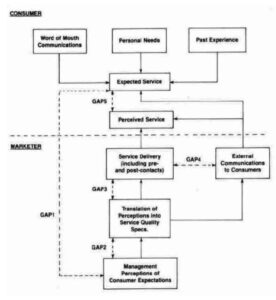The SERVQUAL Model
The SERVQUAL Model is an empiric model by Zeithaml, Parasuraman and Berry to compare service quality performance with customer service quality needs. It is used to do a gap analysis of an organization’s service quality performance against the service quality needs of its customers.That’s why it’s also called the GAP model.
It takes into account the perceptions of customers of the relative importance of service attributes. This allows an organization to prioritize.
There are five core components of service quality:
1. Tangibles – physical facilities, equipment, staff appearance, etc.
2. Reliability – ability to perform service dependably and accurately.
3. Responsiveness – willingness to help and respond to customer need.
4. Assurance – ability of staff to inspire confidence and trust.
5. Empathy – the extent to which caring individualized service is given.
The four themes that were identified by the SERVQUAL developers were numbered and labelled as:
1. Consumer expectation – management perception gap (Gap 1): Management may have inaccurate perceptions of what consumers (actually) expect. The reason for this gap is lack of proper market/customer focus. The presence of a marketing department does not automatically guarantee market focus. It requires the appropriate management processes, market analysis tools and attitude.
2. Service quality specification gap (Gap 2): There may be an inability on the part of the management to translate customer expectations into service quality specifications. This gap relates to aspects of service design.
3. Service delivery gap (Gap 3): Guidelines for service delivery do not guarantee high-quality service delivery or performance. There are several reasons for this. These include: lack of sufficient support for the frontline staff, process problems, or frontline/contact staff performance variability.
4. External communication gap (Gap 4): Consumer expectations are fashioned by the external communications of an organization. A realistic expectation will normally promote a more positive perception of service quality. A service organization must ensure that its marketing and promotion material accurately describes the service offering and the way it is delivered
5. These four gaps cause a fifth gap (Gap 5), which is the difference between customer expectations and perceptions of the service actually received Perceived quality of service depends on the size and direction of Gap 5, which in turn depends on the nature of the gaps associated with marketing, design and delivery of services.So,Gap 5 is the product of gaps 1, 2, 3 and 4. If these four gaps, all of which are located below the line that separates the customer from the company, are closed then gap 5 will close.


